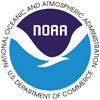Map Layer Info
| Seasonal Sea Surface Temperature Averages, 1985-2001 | |
What this map layer shows: Seasonal Sea Surface Temperature for the entire Earth, for the years 1985-2001. |
 |
| Background Information | |
 Sample Map
Sample Map
SST data are collected as part of the 4 km Pathfinder effort at the National Oceanic and Atmospheric Administration (NOAA) National Oceanographic Data Center (NODC) and the University of Miami's Rosenstiel School of Marine and Atmospheric Science (RSMAS). The Pathfinder project used Advanced Very High Resolution Radiometer (AVHRR) data from the NOAA-9, NOAA-11, NOAA-14, and NOAA-16 satellites. The seasonal SST averages were compiled by the NODC. The 4 km Pathfinder effort at NODC is an improvement to the original Pathfinder program, which was jointly developed by the National Aeronautics and Space Administration (NASA) and NOAA to provide long-term, consistently calibrated global-change data sets to Earth scientists. The Pathfinder SSTs are used in a wide variety of scientific and technical applications. For example, scientists use SST data to study changes in ocean temperature over the last 20 years and the impact of those changes on marine ecosystems; studies of thermally induced coral bleaching are a common use in this area. Numerical modelers also use SST data to validate and better understand their model outputs by comparing Pathfinder SST climatologies with their own results. Observational oceanographers use Pathfinder data to provide high spatial and temporal resolution imagery of SSTs in the vicinity of their research cruises, to better understand the larger context in which their vessel is operating. The Seasonal Sea Surface Temperature Averages, 1985-2001 data set consists of four images showing seasonal SST for the entire Earth. Grid cell values represent SST in 0.15-degree Celsius (0.27-degree Fahrenheit) increments. The National Atlas distributes the SST data as GeoTIFFs, but the data are also available from the NODC Ocean Archive System in Hierarchical Data Format, with grid cell values representing 0.075-degree Celsius (0.14-degree Fahrenheit) increments. |
|
| Climate |
| Map Maker Sample |
| Sea Surface Temperature 1985-2001: July-September |
